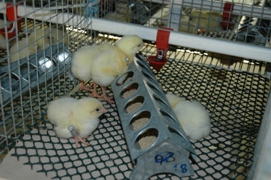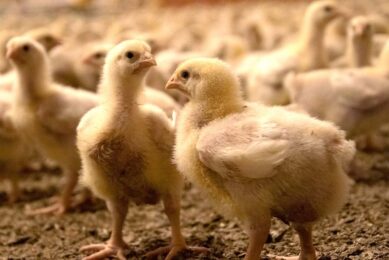Good start from early post hatch feed

Newly hatched chicks are very sensitive to environmental factors. Feed availability and ambient temperatures are such factors. Recent research indicates that early post hatch feed and the composition of this feed positively affect early development and improve the hatchlings’ resistance against cold.
By Dr. Roos Molenaar, senior researcher HatchTech and Dr. Henry van den Brand, Associate Professor, Wageningen University, the Netherlands
The production cycle of the broiler chicken has been decreased over the years and will probably decrease even more in the future. The period immediately after hatch, when major developmental and physiological changes occur, becomes more and more important. A broiler chicken seems anatomically complete after hatch, but the digestive, immune, and thermoregulatory system needs further development and maturation. Early feed is essential for the development of the gastrointestinal tract and the growth of the bird, but it is largely unknown what the effect of early feed is on the development of the thermoregulatory system.
Thermoregulatory development
In practice, birds are often delivered at the broiler farm up to 72 hours after emergence from the eggshell, because of the time needed for hatching, chick handling and transport. This delays the start of feed consumption and negatively affects body weight by a decrease in intestinal development and muscle growth. A delay in feed consumption may also affect the development of thermoregulation. In the early post hatch period, chickens act as poikilotherm and become fully homeotherm during the first 5 to 10 days after hatch.
In practice, birds are often delivered at the broiler farm up to 72 hours after emergence from the eggshell, because of the time needed for hatching, chick handling and transport. This delays the start of feed consumption and negatively affects body weight by a decrease in intestinal development and muscle growth. A delay in feed consumption may also affect the development of thermoregulation. In the early post hatch period, chickens act as poikilotherm and become fully homeotherm during the first 5 to 10 days after hatch.
The optimal body temperature of post hatch chickens is between 40.0°C and 40.6°C. When birds are within this narrow body temperature range, they are in their thermal neutral zone and show normal eating, drinking, and sleeping behaviour. Early feed may positively affect the development and maturation of the thermoregulatory system and specific nutrient components may play an important role in this development and maturation. To investigate the effect of different diet compositions on thermoregulatory development of early fed chickens, a study was performed at Wageningen University, the Netherlands. Rectal temperature and the decrease in rectal temperature during cold exposure were used as variables to express thermoregulatory development.
Diet composition variation
Newly hatched chickens from a Hybro grandparent broiler breeder flock of 40 weeks of age were taken from the hatcher at day 20 of incubation and were immediately assigned to one of five treatments.
Newly hatched chickens from a Hybro grandparent broiler breeder flock of 40 weeks of age were taken from the hatcher at day 20 of incubation and were immediately assigned to one of five treatments.
The treatment groups were: 1) no feed, 2) crushed dextrose pellets, 3) boiled albumen, 4) a commercial prestarter (12.0 MJ of ME/kg, 232 g/kg of crude protein, 65 g/kg of crude fat) and 5) a commercial prestarter plus extra fat (13.7 MJ of ME/kg, 232 g/kg of crude protein, 149 g/kg of crude fat). Water was available ad libitum. Room temperature was set at 35°C at arrival and decreased by 0.5°C until three days post hatch. At day 2 and 3 post hatch, half of the chickens were housed individually in wired cages and exposed to a cold temperature (20°C) for 30 minutes. Their rectal temperature was measured before, immediately after, and 30 minutes after the cold exposure.
Body temperature control
Results showed that rectal temperatures before cold exposure were higher in chickens fed the prestarter diet and the prestarter diet plus fat (40.6°C and 40.7°C, respectively) and dextrose (40.4°C) compared to chickens without feed (39.5°C) and chickens fed albumen (39.8°C) (see Figure 1). The rectal temperature dropped during the cold exposure in all treatments.
The strongest decrease in rectal temperature was found in chickens fed albumen (2.1°C), followed by chickens without feed (1.2°C), chickens fed dextrose (1.2°C), and finally chickens fed with the prestarter and the prestarter plus extra fat (0.6°C and 0.7°C, respectively). The highest body weights were obtained in chickens fed the prestarter diets, the chickens weighed on average 70 gram at three days post hatch. The chickens fed albumen had a higher body weight than chickens without feed or chickens fed dextrose (44 vs both on average 39 gram, respectively) at three days post hatch.
Importance of post hatch feed
The chickens that were fed prestarter diets had a higher initial rectal temperature and were more resistant against the cold exposure, expressed by a smaller decrease in rectal temperature, than the other treatments. This result may indicate that post hatch feed stimulates the development of the thermoregulatory system. On the other hand, chickens fed the prestarter diets may have had a higher energy intake and heat production that improved the resistance against cold.
The chickens that were fed prestarter diets had a higher initial rectal temperature and were more resistant against the cold exposure, expressed by a smaller decrease in rectal temperature, than the other treatments. This result may indicate that post hatch feed stimulates the development of the thermoregulatory system. On the other hand, chickens fed the prestarter diets may have had a higher energy intake and heat production that improved the resistance against cold.
An interesting result was that chickens that were fed dextrose, who had a low body weight and probably low heat production, were able to maintain their body temperature before and during the cold exposure. Dextrose, which is a fast available carbohydrate source, may be used to restore the glycogen (=carbohydrates) content in the chicken’s body. Glycogen is used during the energy demanding hatching process to emerge from the eggshell. Dietary carbohydrates may increase glycogen stores and positively influence the maintenance of body temperature in post hatch chickens.
Sufficient fat levels
No differences were found between the chickens fed the prestarter and the prestarter plus extra fat. The extra fat source that was used in the current study was tallow, which consists of saturated long-chain fatty acids. The post hatch chicken can absorb long-chain fatty acids, because this is also the major energy source during incubation. The levels of fat in the prestarter in the current study may have been already sufficient and including extra fat may, therefore, have not influenced the resistance against cold.
No differences were found between the chickens fed the prestarter and the prestarter plus extra fat. The extra fat source that was used in the current study was tallow, which consists of saturated long-chain fatty acids. The post hatch chicken can absorb long-chain fatty acids, because this is also the major energy source during incubation. The levels of fat in the prestarter in the current study may have been already sufficient and including extra fat may, therefore, have not influenced the resistance against cold.
In conclusion, early post hatch feed and the composition of this feed affect hatchling development and improve the resistance against cold. This indicates that post hatch feed has a positive effect on body temperature control.
Join 31,000+ subscribers
Subscribe to our newsletter to stay updated about all the need-to-know content in the poultry sector, three times a week. Beheer
Beheer








 WP Admin
WP Admin  Bewerk bericht
Bewerk bericht